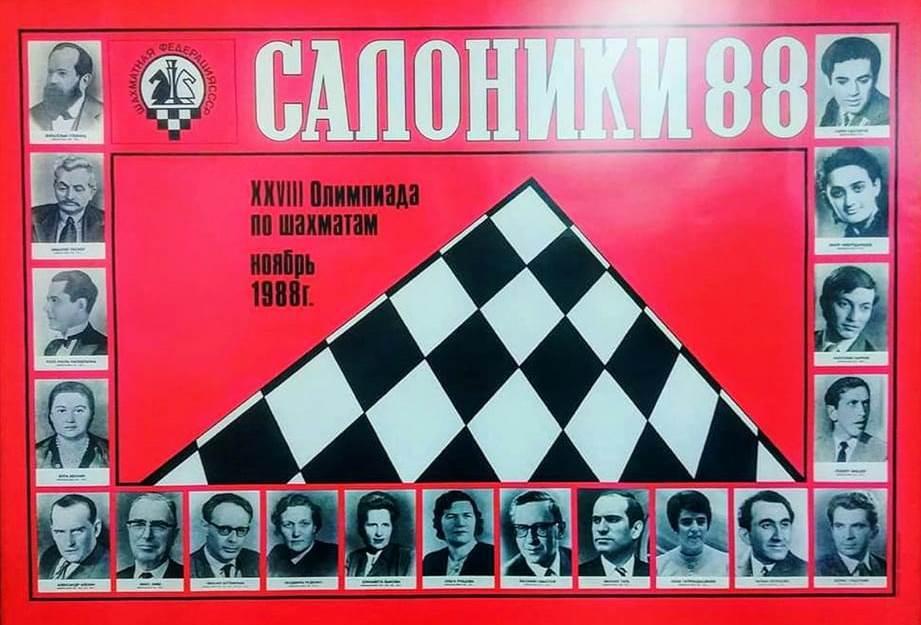 28th Chess Olympiad 1988
28th Chess Olympiad 1988
36 years ago (1988) the 28th Chess Olympiad was played in Thessaloniki, Greece. This was the second time we had seen this glorious event (after 1984), in the beautiful and historical Greek town of Thessaloniki. For me it was a very memorable event; it was already my fourth Olympiad – 1982 as a spectator and 1984, 1986 and 1988, as a player.
And it was played in my home town at that time. I spent three years (1988-1990) in Thessaloniki, where I ran a chess related business, the ‘Kaissa Chess Center’. And memorable as well, as during the Olympiad I met my future wife. She was among the spectators and even asked me for an autograph…
The 28th Chess Olympiad 1988 was played in-between November 12th to 30th, as a 14-round Swiss System event, with 107 teams participating in the Open section. The playing venue was the Thessaloniki International Fair and teams were staying in various hotels around the town.
Each national team consisted of six players, with four of them playing in every round.
The Historical Data
The Soviet Union won the Olympiad in convincing style, with a total of 40½ points. The struggle for the silver medals, however, was extremely close. Going into the last round, England had 33 points, ahead of USA, Hungary and Holland, each with 32 points. The USA were to play Hungary while England faced Holland. The USA-Hungary match was 1½-1½ with one adjourned game (Csom-Christiansen).

This was finally drawn and both Hungary and the USA ended up with 34 points each. The crunch came in the England-Holland match. If England could hold the draw 2-2 or do even better, the silver medals were theirs. Speelman drew with Sosonko. Short was quite lucky to halve with Van der Wiel. Nunn seemed quite lost against Van der Sterren but managed to make out a draw. Chandler however lost to Piket and thus the Dutch won the match 2½-1½. This put both teams at 34½ point line.
Of four possible tie-break methods, three of them favoured the Dutch, but the Buchholz method used as major tie-break gave the Dutch only 455.0 compared to English 457.0. England won the silver and the Dutch had to be satisfied with the bronze. The USA stayed in tied 4th together with Hungary, disappointing for both teams. Yugoslavia finished in 6th place ahead of the Philippines and China (all-time best for both Asian teams).
Argentina were back in top 10 – after 12 years of struggle. Tied 12th was a par for Sweden, a huge disappointment for Czechoslovakia and intense success for the Italians. Both German teams were lying in tied 15th. Bulgaria and Romania were already suffering crisis of communist block – both outside top 20.

In the Women section, Hungary, with the three Polgars playing, dominated the field. A small video can be watched in Youtube, among many other of course!
The Greek Team
The Greek Team, captained by the famous Efim Geller, had a ‘usual’ tournament, ending in the honourable 27th place with 31 game-points. I didn’t play that well, as my coach had decided that I should play all the rounds (!), so I was exhausted and I had many ups and downs.
For me it was always an honour to represent my country’s Men National Team. I did so in 22 events, were I played 174 games (+56 =85 -33), winning as well the 3rd Board Gold Medal in 1989 and the 3rd Board Silver Medal in 1998. But I had two memorable games to remember; two games that gave my National team the win!
It is always great when your team wins and you have scored the winning goal! And this great moment happened to me twice in this Olympiad!
You can’t imagine how proud I was feeling, especially after the games when my country’s fellow man were congratulating me, while I was walking around the playing hall. And of course, when the newspapers were describing the incident with full praise! Well, for a 22-years-old lad (like me at 1988) that was heaven!
The first great moment came early, in round 6 and it was against the strongest (by rating) team from Australia. My opponent was helpful, I must confess, but I still had to play a good game to prove my superiority.
Well, let’s see some action!

Short CV of International Trainer, grandmaster Efstratios Grivas


















 28th Chess Olympiad 1988
28th Chess Olympiad 1988







